2 - The "Electronicians"
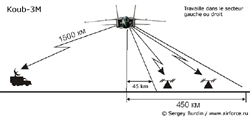
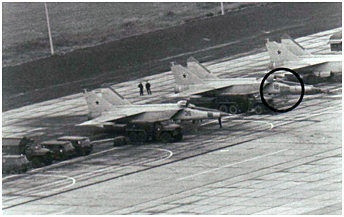 The second branch of the MiG-25 reconnaissance aircraft family was composed of aircraft devoid of optical cameras and exclusively equipped with
electronic reconnaissance gear.
The MiG-25RBK, aka Article 02K "Foxbat-D," was produced in Gor'kiy from 1971 to 1980 and entered service in 1972.
It was a MiG-25RB airframe devoid of traditional cameras but equipped with a Kub-3 (later -3M) ELINT suite designed to detect and identify radars.
The Kub (Куб - Cube) that operated either from the left or the right side of the aircraft, could capture radar emissions
up to a 450 km away - there was a dead zone of 45 km right below the aircraft - and determine their coordinates with an accuracy of two to ten kilometers.
The data collected were digitally recorded and relayed to the ground via a data link connection up to a distance of 1500 km.
An SPS-143 Siren' (Lilac) deception suite protected the aircraft. Moreover, the Peleng-2 navigation complex replaced
the Peleng-DR or -DM variants on these aircraft.
The second branch of the MiG-25 reconnaissance aircraft family was composed of aircraft devoid of optical cameras and exclusively equipped with
electronic reconnaissance gear.
The MiG-25RBK, aka Article 02K "Foxbat-D," was produced in Gor'kiy from 1971 to 1980 and entered service in 1972.
It was a MiG-25RB airframe devoid of traditional cameras but equipped with a Kub-3 (later -3M) ELINT suite designed to detect and identify radars.
The Kub (Куб - Cube) that operated either from the left or the right side of the aircraft, could capture radar emissions
up to a 450 km away - there was a dead zone of 45 km right below the aircraft - and determine their coordinates with an accuracy of two to ten kilometers.
The data collected were digitally recorded and relayed to the ground via a data link connection up to a distance of 1500 km.
An SPS-143 Siren' (Lilac) deception suite protected the aircraft. Moreover, the Peleng-2 navigation complex replaced
the Peleng-DR or -DM variants on these aircraft.
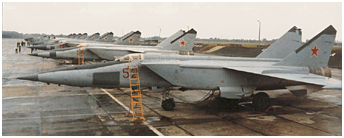
 The MiG-25RBS (Article 02S) "Foxbat-D" was developed at the same time as the RBK variant.
Produced from 1971 to 1977, it also was introduced into service in 1972. The MiG-25RBS carried a Sablya-Ye (Сабля-Е - Saber) side-looking airborne radar
whose presence was betrayed by two large dielectric panels located on each side of the nose. The "Sablya" was only usable from altitudes between 17,000 and 24,000 meters.
It covered a strip of land about 25 km wide either from the left or right side to a distance of 42-47 km (that is to say, the area not covered by the SLAR
immediately beneath the aircraft and its surroundings). The radar resolution was
30 meters, allowing detection of bridges, crossing sites, railway junctions, equipment concentrations, airfields, harbors or boats.
The images were exposed on a film that was processed and analysed on the ground in a specially designed truck.
The resolution varied depending on the flight speed: the higher it was, the higher was the definition. However, maintaining the optimal parameters in supersonic flight
was not easy. It was in fact the most difficult reconnaissance mission.
An SPS-142 Siren' system protected the aircraft against the firing site radars. Also, the older Peleng-DR or -DM navigation complex variants
were replaced with the Peleng-2.
The MiG-25RBS (Article 02S) "Foxbat-D" was developed at the same time as the RBK variant.
Produced from 1971 to 1977, it also was introduced into service in 1972. The MiG-25RBS carried a Sablya-Ye (Сабля-Е - Saber) side-looking airborne radar
whose presence was betrayed by two large dielectric panels located on each side of the nose. The "Sablya" was only usable from altitudes between 17,000 and 24,000 meters.
It covered a strip of land about 25 km wide either from the left or right side to a distance of 42-47 km (that is to say, the area not covered by the SLAR
immediately beneath the aircraft and its surroundings). The radar resolution was
30 meters, allowing detection of bridges, crossing sites, railway junctions, equipment concentrations, airfields, harbors or boats.
The images were exposed on a film that was processed and analysed on the ground in a specially designed truck.
The resolution varied depending on the flight speed: the higher it was, the higher was the definition. However, maintaining the optimal parameters in supersonic flight
was not easy. It was in fact the most difficult reconnaissance mission.
An SPS-142 Siren' system protected the aircraft against the firing site radars. Also, the older Peleng-DR or -DM navigation complex variants
were replaced with the Peleng-2.
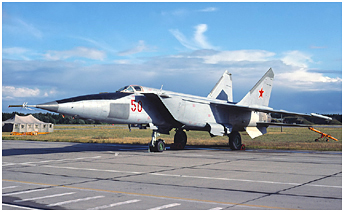 The MiG-25RBS were upgraded from 1978-79 on, when their Sablya were replaced with another, more efficient, SLAR called Shompol (Шомпол - Ramrod)
that had three times higher resolution. Moreover, it could be used between 300 and 23,000 meters and it was possible to select moving targets.
Shompol also had a mapping mode. The upgraded aircraft logically took the designation of MiG-25RBSh alias Article 02Sh (1) "Foxbat-D."
It was in principle possible to distinguish the upgraded aircraft from the RBS models thanks to some of the antennas of the retrofitted SPO-15 Bereza (Birch)
radar homing and warning receiver located on the upper part of the engine air intakes.
Also from 1978-79 on, a MiG-25RBK modernization project began, thus turning platforms into MiG-25RBF (Article 02F) "Foxbat-D."
The MiG-25RBS were upgraded from 1978-79 on, when their Sablya were replaced with another, more efficient, SLAR called Shompol (Шомпол - Ramrod)
that had three times higher resolution. Moreover, it could be used between 300 and 23,000 meters and it was possible to select moving targets.
Shompol also had a mapping mode. The upgraded aircraft logically took the designation of MiG-25RBSh alias Article 02Sh (1) "Foxbat-D."
It was in principle possible to distinguish the upgraded aircraft from the RBS models thanks to some of the antennas of the retrofitted SPO-15 Bereza (Birch)
radar homing and warning receiver located on the upper part of the engine air intakes.
Also from 1978-79 on, a MiG-25RBK modernization project began, thus turning platforms into MiG-25RBF (Article 02F) "Foxbat-D."
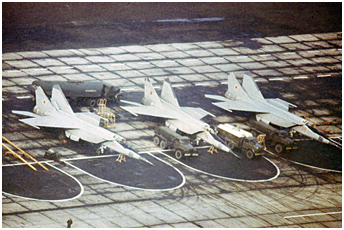
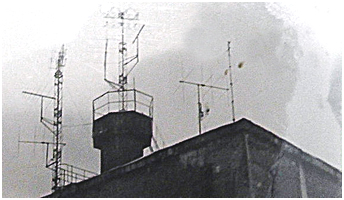 Seules les variantes RBK et RBF du MiG-25 étaient en mesure de transmettre par data link le résultat de leurs reconnaissances.
Contrairement aux procédures de guerre qui voulaient que tous les équipements soient mobiles, les données étaient transmises vers un ancien bunker
de la Luftwaffe à Werneuchen en partié dédié à cette tâche, plutôt que vers un complexe mobilie monté sur camion.
© I.Maksimov.
Seules les variantes RBK et RBF du MiG-25 étaient en mesure de transmettre par data link le résultat de leurs reconnaissances.
Contrairement aux procédures de guerre qui voulaient que tous les équipements soient mobiles, les données étaient transmises vers un ancien bunker
de la Luftwaffe à Werneuchen en partié dédié à cette tâche, plutôt que vers un complexe mobilie monté sur camion.
© I.Maksimov.
The only MiG-25 variants able to transmit by data link the results of their reconnaissance flights were the RBK and RBF models.
Unlike wartime procedures that dictated that all equipment should be mobile, the data were transmitted to an old Luftwaffe bunker
at Werneuchen that was partly dedicated to this task, rather than to a truck-mounted complex. © I.Maksimov.
The Shar-25 (Шар - Sphere) complex replaced the Kub-3M ELINT suite. The new system worked faster
and remained efficient in a disturbed radio environment. It could detect recent radars working in a complex emission
spectrum and data collected were sent via data link to a receiving station on the ground for analysis.
Here also, the Peleng-2 navigation complex was retroffited together with an SPO-15 RHWR.
Like with all other upgraded versions, the modification of the MiG-25RBK into MiG-25RBF was done in the maintenance center (ARZ - Aviatsionnyy Remontnyy Zavod)
in Zaporozh'ye. Logically, the MiG-25RBF should have taken the designation MiG-25RBSh in relation to their Shar-25 ELINT suite.
However, that designation had already been taken by the MiG-25RBSh equipped with the Shompol ELINT suite as mentioned above.
| MiG-25RBSh or MiG-25RBF? |
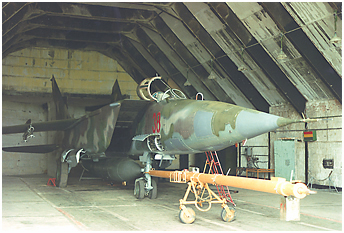
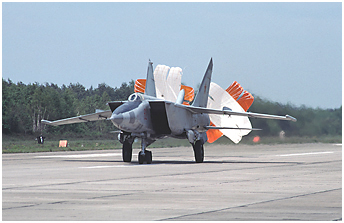 While the vast majority of the MiG-25 from the 931.OGRAP had the traditional light grey camouflage pait scheme usually
applied to this aircraft type, MiG-25RBF bort number 38 red (serial number 02032317) had an unusual livery.
That particular "Foxbat-D" had a tactical camouflage paint scheme composed of dark brown, sand and dark green on the upper surfaces and dark grey on the underside.
It was commonly reported that this colour scheme had been applied at the Novosibirsk Maintenance Center; gossips contended
- without any proof or by pure fantasy - that this aircraft was a veteran from the Afghanistan war...
In Russia, other MiG-25 reconnaissance aircraft, and at least one MiG-25BM, bore this type of camouflage that was considered unusual.
However, this practice was common in the VVS.
So it was with some MiG-29 and Su-24 regiments whose aircraft had a brown and green camouflage
rather than grey. Note that this particular aircraft apparently only joined the 931.OGRAP in the late eighties.
While the vast majority of the MiG-25 from the 931.OGRAP had the traditional light grey camouflage pait scheme usually
applied to this aircraft type, MiG-25RBF bort number 38 red (serial number 02032317) had an unusual livery.
That particular "Foxbat-D" had a tactical camouflage paint scheme composed of dark brown, sand and dark green on the upper surfaces and dark grey on the underside.
It was commonly reported that this colour scheme had been applied at the Novosibirsk Maintenance Center; gossips contended
- without any proof or by pure fantasy - that this aircraft was a veteran from the Afghanistan war...
In Russia, other MiG-25 reconnaissance aircraft, and at least one MiG-25BM, bore this type of camouflage that was considered unusual.
However, this practice was common in the VVS.
So it was with some MiG-29 and Su-24 regiments whose aircraft had a brown and green camouflage
rather than grey. Note that this particular aircraft apparently only joined the 931.OGRAP in the late eighties.
3 - Pinocchio
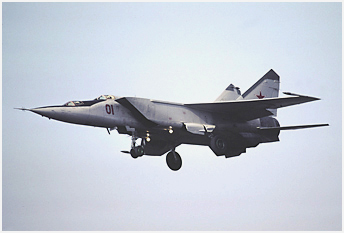
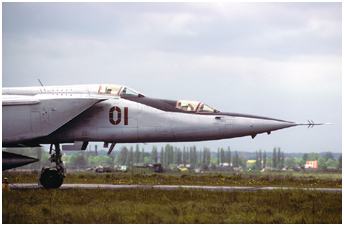 The last squadron of the 931.OGRAP maintained two of the MiG-25RU (RU for Razvedchik Uchebnyy - Reconnaissance Training) - alias "Foxbat-C" or
Article 39 - two-seaters that were part of the original regiment strength for training and weather reconnaissance flights before each flying day.
This MiG-25 variant distinguished itself by a new forward fuselage section where a second cockpit for the instructor had been added lower in front of
the original cockpit. Nevertheless, and despite this unusual addition, the MiG-25RU flying qualities were very close to those of the single-seater version.
However, the maximum speed was limited to Mach 2.65. The RU variant did not have the bomb release control system or a Peleng. Otherwise, its
equipment complement was identical to that of the reconaissance version.
Finally, like most of the Soviet combat aircraft two-seater versions, the MiG-25RU were specially equipped to simulate
failures in flight like with a classic flight simulator (2).
The last squadron of the 931.OGRAP maintained two of the MiG-25RU (RU for Razvedchik Uchebnyy - Reconnaissance Training) - alias "Foxbat-C" or
Article 39 - two-seaters that were part of the original regiment strength for training and weather reconnaissance flights before each flying day.
This MiG-25 variant distinguished itself by a new forward fuselage section where a second cockpit for the instructor had been added lower in front of
the original cockpit. Nevertheless, and despite this unusual addition, the MiG-25RU flying qualities were very close to those of the single-seater version.
However, the maximum speed was limited to Mach 2.65. The RU variant did not have the bomb release control system or a Peleng. Otherwise, its
equipment complement was identical to that of the reconaissance version.
Finally, like most of the Soviet combat aircraft two-seater versions, the MiG-25RU were specially equipped to simulate
failures in flight like with a classic flight simulator (2).
The withdrawal
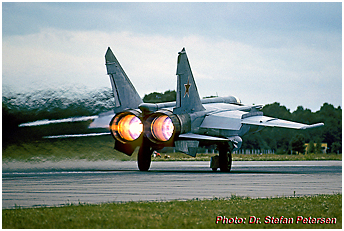
 Un pilote du 931.OGRAP monte à bord d'un MiG-25 de reconnaissance photo à Werneuchen.
© Molodaya Gvardiya.
Un pilote du 931.OGRAP monte à bord d'un MiG-25 de reconnaissance photo à Werneuchen.
© Molodaya Gvardiya.
A pilot from the 931.OGRAP climbs aboard a photo reconnaissance MiG-25. © Molodaya Gvardiya.
On May 21, 1991, the 16 MiG-25 of the 1.AE, equipped for the occasion with their giant of 5280-liter belly tank, moved from
Werneuchen to Welzow with logistical support provided by some Mi-6A "Hook-A" transport helicopters from the 239.OGVP at
Oranienburg. The MiG-25 probably joined the 3.AE of the 11.ORAP whose Su-24MP left Germany on June 5 and 7 that year.
The 931.OGRAP had de facto ceased to exist. The MiG-25 finally left Germany in two waves of aircraft one year later.
Six aircraft left on July 1, 1992 and the ten remaining "Foxbat" of the 16.VA departed Welzow five days later for Shatalovo in the Smolensk region.
The MiG-25 reconnaissance aircraft remained an important asset for the VVS for a long time. They were flying with the 98.OGRAP at Monchegorsk and the
47.OGRAP at Shatalovo (in the Leningrad and Moscow Military districts, respectively). Reporting to the central command since 2000, they were a
strategic reserve force. The last operational MiG-25RB. were located at Monchegorsk (Murmansk oblast) with the 6964th Air Base. They flew their last mission in
December 2013.
| Jamming the Foxbat |
 |
MiG-25 PHOTO PAGE |  |
notes
(1)
RBSh is written RBCh in French or RBSz in Polish...
(2)
That was a common feature that the MiG-25RU/PU shared with other aircraft like MiG-29UB "Fulcrum-B."
The Soviet had long opted for in-flight simulation rather than developing expensive flight simulators.
It seems that the use of basic ground-based flight simulators associated with in-flight exercises offered an
interesting training/effectiveness ratio per flight hour.
 |
931.OGRAP < Part 1 | > Part 3 |
 |
Plan du site - Sitemap |  |
